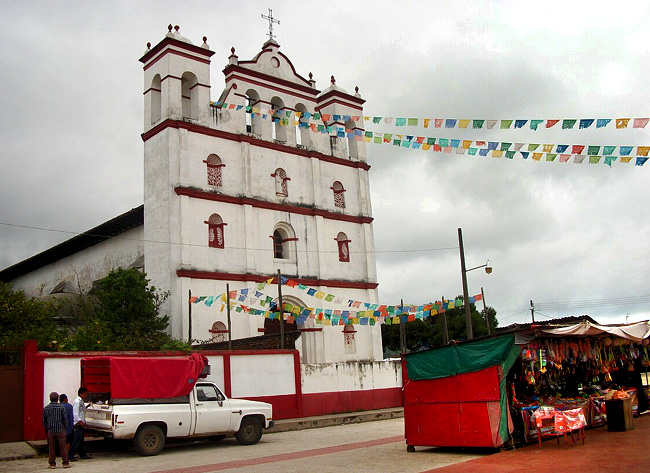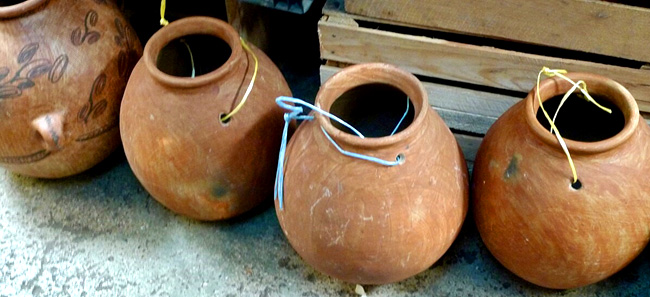
María López López around 1994
Some years ago I wrote a story for American Forests magazine (November/December issue, 1988) on the impact of firewood gathering on southern Mexico's highland forests. For that story I visited Amatenango del Valle, Chiapas, a village of Tzotzil-speaking people twenty miles southeast of San Cristóbal de Las Casas, some sixty miles from the Guatemalan border. Today, remembering that much firewood around Amatenango was gathered to fuel fires for baking earthenware, I return there hoping to learn about the pottery business.
Amatenango lies at an elevation of about 6,000 feet, at the foot of a pine- covered mountain rising to the east. One interesting particular about life in Amatenango is that high up the slope, beside the highway, young men load the firewood they have just cut onto homemade, motorless, go-kart-like contraptions. Then they coast a mile or more, at truly breakneck speed, back down the mountain to Amatenango.

The Templo de San Francisco de Asis in Amatenango del Valle, Chiapas, photographed in 2012; copyright free image courtesy of Darinel Gutierrez de Los Santos made available through Wikimedia Commons.
Amatenango, with a population of maybe five hundred, is a town of small wooden huts, mostly with dirt floors; its streets are unpaved and, typically, rather muddy. The inhabitants of many of Mexico's indigenous villages speak Spanish and wear typical Mexican street-clothing. In Amatenango, all one hears is Tzotzil. The men wear regular street-clothing, but most women dress in traditional huipiles, and long, black dresses. When the women wish to appear formal, they fold a cloth a certain way and place it atop their heads. Amatenango's main square is graced with a pretty church, across from which stands a government building with a comfortable looking veranda; the town's men congregate there, sit in tiny wooden chairs, and gravely conduct never-ending consultations.
As a measure of each household's self sufficiency, in the whole town there is no regular store. Two or three houses informally sell sodas and crackers. Each household consists of one or two modest huts surrounded by a small courtyard containing, among other things, a congenial population of fruit trees, free-roaming chickens, washed clothing drying on bushes, piles of firewood, and -- always -- stacks of pottery. From what I can see, every household makes pottery.
As I wander around looking for someone to talk to, María López López peeps her head through a small courtyard's wobbly gate and asks in faltering Spanish if I want to buy pottery. I explain that I'd rather buy an interview. We agree on a price, and I'm invited to step inside.
María leads me to a room with one open side, the paraphernalia of pottery work lying everywhere. An alter to the Virgin of Guadalupe, set with flickering candles, occupies the back wall. María's hesitant Spanish is very heavily accented with her native Tzotzil. Though she is very quick- witted and desirous of answering all my questions in full, she must always search for the right Spanish word. She never says one word more than she absolutely needs to, and she never volunteers an extra thought. Because I know so little about her primitive manner of firing pottery, it's hard to ask the right questions.
"I am forty-six years old," she says. "I began making clay animals to sell in the mercado when I was nine. I began working with these pots when I was ten. The whole family made pottery, and the whole village. My mother made pottery, and my grandmother. I don't know who first taught us how to do this. My mother taught me, and when I had children, I taught them."

Pots from Amatenango del Valle, Chiapas bought in 2011; copyright free image courtesy of "Juanscott" made available through Wikimedia Commons.
Pottery from Amatenango is considered primitive because it is unglazed, or rough to the touch, and lusterless. I ask how the people in Amatenango bake their earthenware.
"The clay comes from over there," María says, pointing toward the west. "It's about two leagues (two hours of walking) away. There are two or three men there who dig out the clay, and it's good, clean clay. Then we... "
But now María begins using Tzotzil words, and speaking with such a heavy accent that I can't understand what she says. Something about mixing in sand, adding water, her hands hurting because of the cold clay when it's being worked.
"If the sun is good, then the pieces won't break in the fire. But if there is no sun, like today and most days, then many pieces break and I can't sell them. Eight days drying... "
I'm confused as to when painting the pottery takes place and I ask her to repeat the story, but after several failures of communication she looks so discomfited that I let it slide. She asks me to step into the yard and she supplements her words with pantomime. She shows me how she builds mounds of firewood, inside which she positions her pottery and clay animals to be fired. Therefore, she uses no kiln at all; when the firewood finishes burning, her fired clay objects lie among the ashes.
"The firewood is roble (oak)," I understand. "It burns very hot."
I ask her to tell me about the paint she uses.
"The paint is hard to find." she says. Now I understand that she does not use commercially produced paint, but rather natural substances that she herself goes into the mountains to look for.
"Sometimes three or four of us go for the whole day looking for it," she continues. "Sometimes we find it but sometimes not. But what we find is good. It doesn't come off."
She places before me several small lumps of rusty-red clay wrapped tightly in clear plastic. María pantomimes how she mixes this clay with water and then daubs on the reddish emulsion. No wonder this paint does not come off, for it is itself clay, like the pottery; once it is fired, it will adhere like rust on a nail. Now I ask about the economics of her business.
"We have to pay bus fare to San Cristóbal and Comitán, where we sell our things," she says. "We have to pay for every shipment, U.S. 83 cents for each costal (sack or large bag). It's expensive. The money that's left after we pay all expenses hardly pays for food."
These last words I understand very well. María asks for double the fee we had agreed on, because the interview has taken more time than I'd said, and I gladly pay.
Leaving María's, I do not go looking for someone else who speaks better Spanish, and who can make clear at what point the ocher paint is applied to the pieces. No, María has expressed herself adequately.